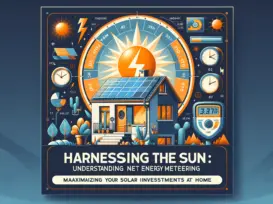Grus Home Energy - Solar PV Systems
The Future of Renewable Energy: Harnessing the Sun with Advanced Solar PV Systems
The Future of Renewable Energy: Harnessing the Sun with Advanced Solar PV Systems
The quest for sustainable and environmentally friendly energy sources has led to significant advancements in solar photovoltaic (PV) technology. Solar PV systems are increasingly becoming a crucial part of the global energy mix, offering a clean, inexhaustible, and now more than ever, economically viable source of power. From individual homeowners to large utility-scale installations, solar PV systems are harnessing the sun’s energy to deliver electricity across the globe.
Solar PV systems work by converting sunlight directly into electricity using solar cells, typically made from semiconductor materials. When photons from sunlight strike these cells, they knock electrons loose, creating a flow of electricity. This process is known as the photovoltaic effect, which is the fundamental principle behind solar PV systems.
One of the most significant developments in the field of solar PV technology is the improvement in efficiency. Modern solar panels can convert a larger percentage of sunlight into electricity than ever before, making them more practical for a wider range of applications. Efficiency advancements, coupled with economies of scale in manufacturing, have also led to a substantial decrease in the cost of solar panels, contributing to their widespread adoption.
Another key aspect that is fuelling the growth of solar PV systems is the diversification of their applications. Residential solar installations allow homeowners to generate their own electricity, reducing their reliance on the grid and lowering energy bills. Community solar projects enable those who cannot install solar panels on their own properties to benefit from solar energy. At the utility scale, solar farms are providing substantial proportions of electricity to national grids, with some regions experiencing days where solar power meets the majority of energy demand.
Storage solutions such as batteries are becoming an integral part of solar PV systems. The intermittent nature of solar energy—whereby power generation is subject to weather conditions and daylight hours—necessitates a method to store excess energy. Batteries enable this energy to be saved for use during cloudy days or nighttime, enhancing the reliability of solar power. Innovations such as lithium-ion batteries have made storage more efficient and cost-effective, allowing for more consistent solar energy integration into the energy grid.
The environmental benefits of solar PV systems are also significant. Unlike fossil fuels, solar energy does not produce harmful emissions that contribute to climate change and air pollution. This clean energy transition is not just about mitigating environmental impacts, but also about creating a more resilient energy system that reduces dependence on volatile fossil fuel markets.
Governments around the world are recognizing the potential of solar PV systems and are providing incentives to encourage their uptake. These incentives include subsidies, feed-in tariffs, and tax credits. Such policies have been instrumental in accelerating the deployment of solar energy systems and in driving technological innovations.
In conclusion, solar PV systems are at the forefront of the renewable energy revolution. With advancements in efficiency, cost reductions, and the development of effective storage solutions, they offer a promising and sustainable alternative to traditional energy sources. As technology continues to evolve and the world increasingly turns towards renewable energy sources to power its future, solar PV systems stand out as a key player in the transition to a cleaner, more sustainable energy landscape.
©2025 All Rights Reserved. Grus IoT Co.,Ltd.
